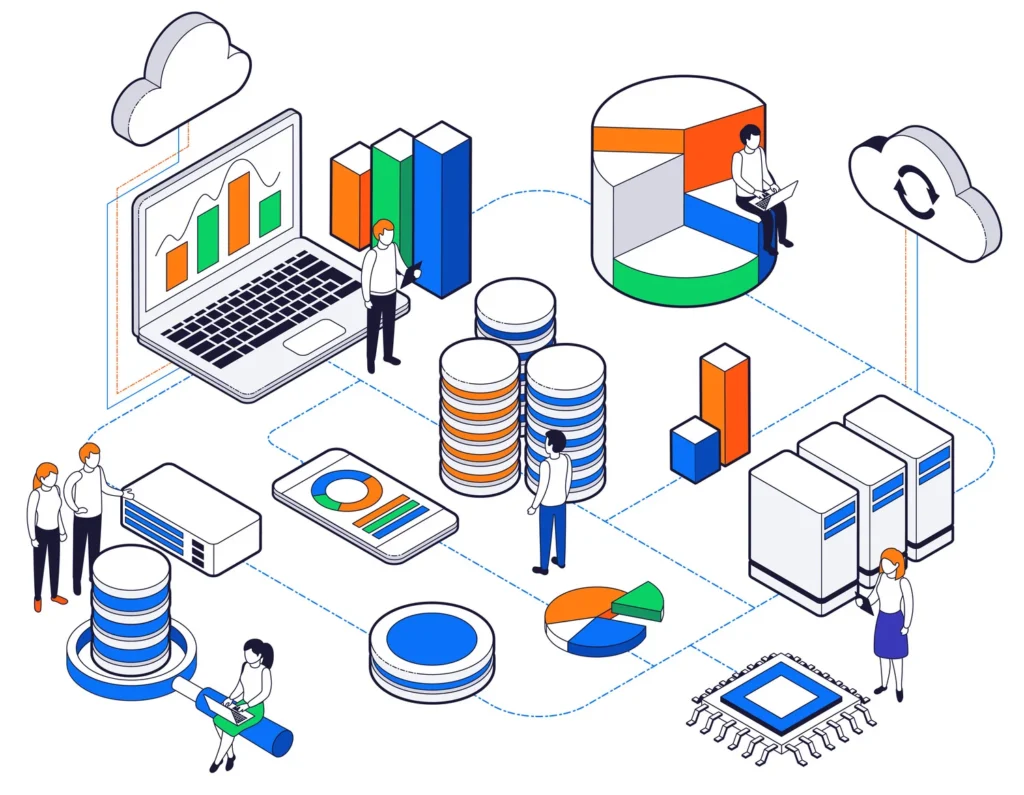Data Lifecycle Management (DLM) is a policy-based approach to best practices to help organisations efficiently handle their data from its creation to its disposal. This life cycle includes stages such as data collection, storage, processing, analysis, and archiving.
While businesses rely heavily on data to make strategic decisions today, this methodology is becoming increasingly important to understand. A managed data lifecycle enables a business to make informed decisions and gain a competitive advantage in the market.
So, what is data lifecycle management? What are the stages and steps required to implement an effective data management strategy? Let us break it down.
What is Data Lifecycle Management?
Organisations use data lifecycle management to keep track of their data from the time it is created until it is thrown away. This process has steps like gathering data, storing it, processing it, analysing it, and archiving it.
Maintaining the privacy, integrity, and availability of data throughout its lifecycle is what data lifecycle management is all about for organisations.
The amount of data that businesses create is growing at an exponential rate, making it more and more important to manage data effectively and safely. A good DLM strategy can help businesses lower the risk of sensitive data being accessed by people who shouldn’t be able to and data being lost because of malware and other infections.
Stages in the Data Life Cycle
The data lifecycle is made up of several stages or steps. The word “cycle” is used to describe these steps because the lessons and insights gained from one data project often help with the next. The last step of the process feeds back into the first one in this way.
There can be different numbers of stages in the data life cycle. Though some say there are eight, others say there are five. However, in general, the stages include data generation, processing, and interpretation. In this article, we quote the Harvard Business School Online post, which divides the data lifecycle into 8 stages or steps.
Stage 1: Data Generation
Before the data life cycle can start, data has to be made. Otherwise, the next steps won’t be able to begin. You’re creating data even if you’re not aware of it, especially in a world that is becoming more and more online. Some of this data comes from your business, some from your customers, and some from outside sources that you may or may not know about.
Everything that is sold, bought, hired, communicated with, or interacted with creates data. You can often learn a lot from this data that will help you serve your customers better and do your job better if you pay attention to it.
Stage 2: Data Collection
Every day, a lot of data is made, but not all of it is collected or used. You should let your data team decide what data is important and how to best collect it, as well as what data isn’t needed or isn’t related to the project at hand.
There are many ways to collect data, such as:
- Forms: Some of the most common ways for businesses to collect data are through web forms, vendor forms, HRIS applications, and forms for clients or customers.
- Questions: Questions in surveys can be a good way to get a lot of information from a lot of people.
- Interviews: You can get qualitative and subjective information that might be hard to get any other way by talking to customers, users, or job applicants in interviews or focus groups.
- Direct observation: Watching how a customer uses your website, app, or product can be a good way to get information that the other methods might not give you.
Additionally, it is important to keep in mind that lots of businesses collect a lot of data from all of their interactions and keep it for possible future use. Even though you could use this source, you should always start by making a plan to get the information you know is important for your project.
Stage 3: Data Processing
Once information has been gathered, it needs to be processed. Data processing can mean a number of different things, such as:
- Data wrangling: People clean up and change a set of data from its original form to something that is easier to access and use. This can also be called data cleaning, data munging, or data repair.
- Data compression: It is possible to store more data by changing it into a format that can be compressed.
- Data encryption: When data is encrypted, it is changed into a different type of code to keep it safe from prying eyes.
For example, in a retail company, data processing may involve cleaning up customer transaction data to remove duplicate entries and errors, making it easier to analyse sales trends. Additionally, the company may compress large amounts of inventory data to save storage space and encrypt sensitive customer information to protect it from hackers.

Stage 4: Data Storage
Data needs to be stored so that it can be used again in the future. Building databases, or datasets, is usually the best way to do this. After that, these datasets can be kept in the cloud, on servers, or on a hard drive, CD, cassette, or floppy disc, among other things.
When figuring out the best way for your business to store data, it’s important to include some redundancy. This way, you can be sure that a copy of your data will be safe and easy to access, even if the original source gets damaged or hacked.
Stage 5: Data Management
Data management, which is also known as database management, is the process of organising, storing, and getting data when it’s needed during a data project.
No matter what time it is, this process, which is called a “step,” goes on all the way through a project. Data management includes a lot of different tasks, such as keeping data safe and encrypting it, as well as setting up access logs and changelogs to keep track of who has viewed and changed data.
Managing large amounts of data can be challenging. That’s why you might require data management tools. Our article, “Data Management Tools: What They Are and 5 Top Recommendations“, will teach you about data management tools and the best ones to use.
Stage 6: Data Analysis
Data analysis is the process of trying to find useful information in large amounts of data. Analysts and data scientists do these kinds of analyses with various sets of tools and methods.
Machine learning, statistical modelling, algorithms, artificial intelligence, and data mining are some of the most common ways to do this.
Who actually does the analysis depends on the problem that needs to be solved and the size of your company’s data team. There is a place for business analysts, data analysts, and data scientists.
Stage 7: Data Visualisation
Making graphs out of your data is what data visualisation is all about. This is usually done with one or more visualisation tools. When you visualise data, it’s easier to quickly share your analysis with more people inside and outside your organisation.
What kind of visualisation you make depends on the data you have and the story you want to tell. Data visualisation is becoming more and more important in the data life cycle, but it’s not necessary for all projects.
Stage 8: Data Interpretation
Finally, the interpretation phase of the data life cycle lets you figure out what your analysis and visualisation mean.
In this step, you do more than just present the data; you also look into it using your knowledge and experience. Not only should you describe or explain what the data means, but you should also think about what it might mean in the future.
You now understand all of the stages involved in data lifecycle management. If you come from a technical background, you should understand how a data management system works. Learn more about that in our article, “Data Management System: What and Why Is It Important for Businesses.”
Conclusion
Finally, learning about data lifecycle management can help businesses manage their data more effectively. Doing this in stages can help you gain a better understanding of where data comes from and the process it goes through before it is received as valuable insights to drive innovation in your business.
Now, are you ready to take your data management to the next level?
Nexalab data visualisation service can help you make sense of your data, turning it into valuable insights that drive strategic decisions.
We offer the data management tools for you, including Interactive Dashboards, Data Integration and Aggregation, Advanced Analytics and Forecasting, Automated ETL Workflows, Customised Visualisations, Real-time Data Updates, Data Quality and Validation, and Security and Compliance.




